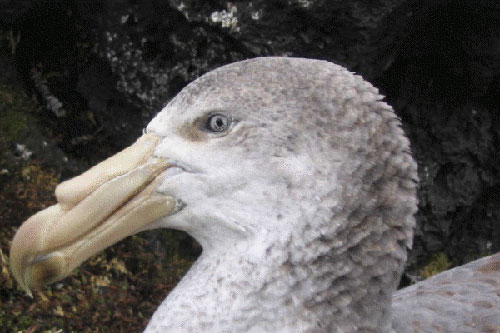The demographics of Northern Giant Petrels Macronectes halli have been intensively studied at South Africa's Marion Island since 1974. Each year a complete "round-island" census is undertaken during incubation and late chick-rearing to obtain trend data in both annual breeding population size and annual production. Numbers of Northern Giant Petrels at Marion have remained fairly constant since 1996/1997. The estimate of the total population in 2008 was 365 ± 45 pairs.
In addition, an area on the island's east coast is studied in more detail with all the nests present each year marked at laying, breeding birds colour-banded and nest contents checked at intervals throughout the breeding season.

Studies are now being expanded to include movements at sea. In a joint project between Peter Ryan, Percy FitzPatrick Institute, University of Cape Town and Jacob González-Solís, Department of Animal Biology, Barcelona University, geolocator (GLS) loggers are to be deployed on Northern Giant Petrels at Marion Island to assess sex differences in at-sea dispersal. Thirty loggers will be deployed by field researcher Mia Cerfonteyn on breeding adults (15 of each sex) this breeding season and recovered from austral spring 2011. The same numbers will be placed in the same season on Southern Giant Petrels M. giganteus to ascertain species-specific differences.
References:
Cooper, J., Brooke, M.deL., Burger, A.E., Crawford, R.J.M., Hunter, S. & Williams, A.J. 2001. Aspects of the breeding biology of the Northern Giant Petrel (Macronectes halli) and the Southern Giant Petrel (M. giganteus) at sub-Antarctic Marion Island. International Journal of Ornithology 4: 53-68.
Crawford, R.J.M., Cooper, J., Dyer, B.M., Greyling, M.D., Klages, N.T.W., Ryan, P.G., Petersen, S.L., Underhill, L.G., Upfold, L., Wilkinson, W., de Villiers, M.S., du Plessis, S., du Toit, M., Leshoro, T.M., Makhado, A.B., Mason, M., Merkle, D., Tshingana, D., Ward, V.L. & Whittington, P.A.. 2003. Populations of surface-nesting seabirds at Marion Island, 1994/95-2002/03. African Journal of Marine Science 25: 427-439. http://www.nisc.co.za/oneAbstract?absId=1014.
Ryan, P.G., Jones, M.G.W., Dyer, B.M., Upfold, L. & Crawford, R.J.M. 2009. Recent population estimates and trends in numbers of albatrosses and giant petrels breeding at the sub-Antarctic Prince Edward Islands. African Journal of Marine Science 31: 409-417. http://www.nisc.co.za/oneAbstract?absId=3305.
John Cooper, ACAP Information Officer with Peter Ryan, Percy FitzPatrick Institute, University of Cape Town, 16 August 2010

 English
English  Français
Français  Español
Español